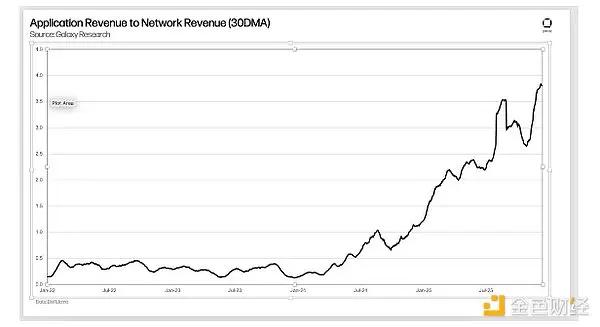Source: ARK; Compiled by Baishuei, Jinse Finance
Bitcoin is a relatively new asset class, and the Bitcoin market is volatile and full of uncertainty. Bitcoin is largely unregulated, and Bitcoin investment may be more susceptible to fraud and manipulation compared to regulated investments. Bitcoin faces unique and significant risks, including large price fluctuations, lack of liquidity, and theft. Bitcoin prices fluctuate wildly, including actions and statements by influential figures and the media, changes in Bitcoin supply and demand, and other factors. There is no guarantee that Bitcoin will maintain its value in the long term.
Market Overview
Bitcoin Reacts to Geopolitical Turmoil
Bitcoin Oversold
In February, the price of Bitcoin fell 17.6%, closing the month at $86,391.
• As of March 3, the Bitcoin price is between its short-term holder (STH) cost basis of $92,020 and its 200-day moving average of $82,005.
• The Fear & Greed Index has reached "Extreme Fear" levels not seen since mid-2022.
• Bitcoin's Spent Output Profit Ratio (SOPR) has fully reset.
Velocity, Uncertainty, Future Growth
Economic indicators, including slowing money velocity growth and declining consumer confidence, suggest businesses and households are more cautious during the political transition.
• Despite near-term uncertainty, ARK remains optimistic about the long-term outlook, as we believe policy changes and technological breakthroughs in areas like artificial intelligence and robotics will reignite consumption and boost productivity.
ARK Key Takeaways
• In February, the price of Bitcoin fell 17.6%, closing the month at $86,391.
• Bitcoin's price is between its short-term holder (STH) cost basis and its 200-day moving average.
• According to the Fear & Greed Index, Bitcoin is oversold.
• Contracting velocity and consumer sentiment suggest future economic weakness.
On-Chain Activity Neutral to Positive
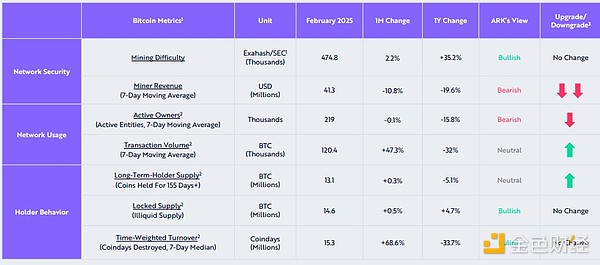
Potential Bull Market Remains Healthy
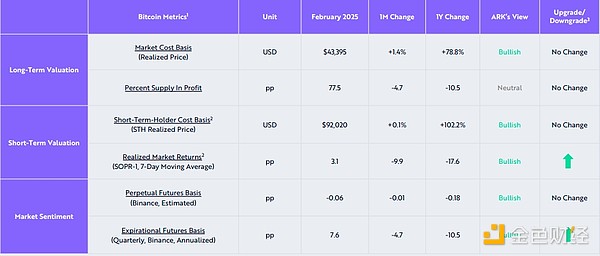
Bitcoin Oversold
Bitcoin Price Oscillates Between 200-Day Moving Average and Short-Term Holder Cost Basis
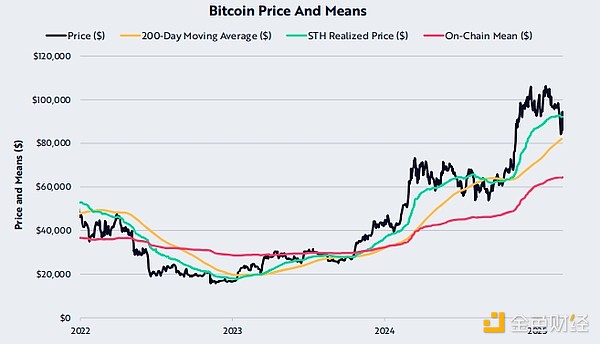
ARK's View: Neutral
• In February, the price of Bitcoin fell 17.6%, closing at $86,391.
• Bitcoin's closing price was below its short-term holder (STH) cost basis of $92,020, but above its 200-day moving average and on-chain average of $82,005 and $64,265, respectively.
• While the major trend remains bullish, the recovery of the short-term holder cost basis is necessary to regain momentum.
Bitcoin's Fear & Greed Index Reaches New 2-Year Low
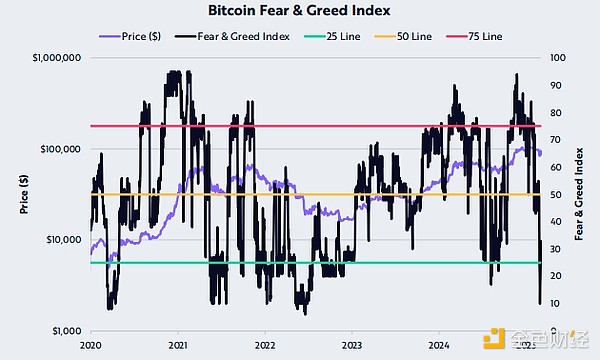
• The Fear & Greed Index has reached "Extreme Fear" levels not seen since mid-2022.
• The index has not reached current fear levels since the start of the current bull market.
• We believe the market's reaction to current macroeconomic and geopolitical sentiment is overly pessimistic.
• The Fear & Greed Index measures a composite indicator from 1 to 100 of Bitcoin's relative volatility, momentum, trading volume, social media sentiment, and Google trends, as well as Bitcoin's market share in the crypto industry.
Bitcoin's SOPR Has Reset
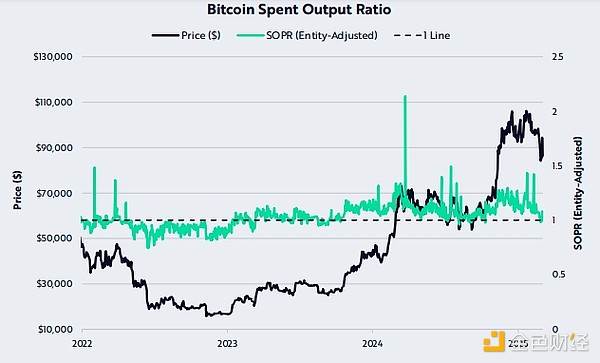
ARK's View: Bullish
Bitcoin's Spent Output Profit Ratio (SOPR) has fully reset to 1.
• In a bull market, SOPR at 1 indicates the market is generally at a breakeven level, often coinciding with local bottoms.
• SOPR tracks the ratio of realized profits or losses to the prices at which those profits and losses were realized.
Bitcoin's Exchange Outflow Cost Basis Suggests Overall Profitability

ARK's View: Bullish
Except for 2025, Bitcoin's annual exchange outflow cost basis has been below its price since 2020, suggesting strong support.
• From 2020 to 2024, Bitcoin's cost basis has ranged from $36,280 to $69,494, indicating healthy unrealized profits and little motivation for panic and capitulation.
• The exchange outflow cost basis tracks the volume-weighted average price (VWAP) of on-chain volume exiting exchanges, suggesting these funds are likely long-term holders.
Bitcoin's 4-Year Compound Annual Growth Rate Hits All-Time Low
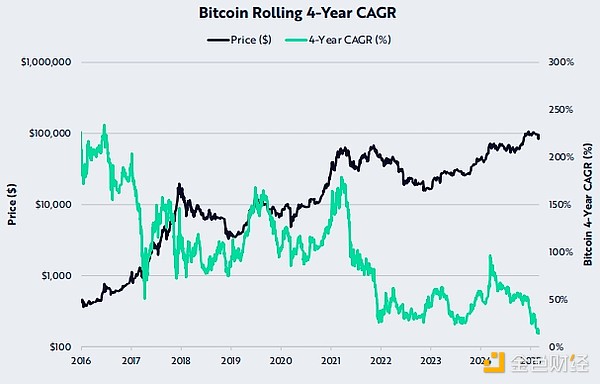
ARK's View: Bearish
• Bitcoin's four-year compound annual growth rate (CAGR) has hit a historic low of 14%.
• While this may impact long-term Bitcoin holders, Bitcoin's relatively low CAGR may also be a signal of Bitcoin being oversold.
Velocity, Uncertainty, and Future Growth
Uncertainty Rises, M2 Money Supply Growth Slows
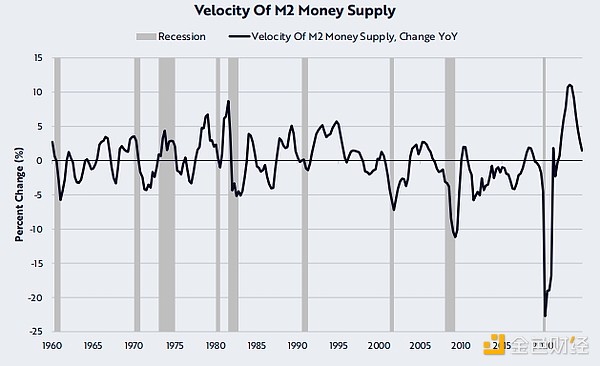
ARK's View: Bearish
• The velocity of money (also known as "money velocity") is slowing.
• Amid the uncertainty of a political transition in the US, consumers and businesses appear to be more cautious.
• Nearly one-third of the workforce (in federal, state, local, and quasi-government positions in education and healthcare) may be concerned about government spending cuts.
• While there are near-term challenges, potential deregulation, tax cuts, and innovation incentives in areas like artificial intelligence and robotics may promote growth and productivity over time.
Consumer Confidence Falls Below Pre-Election Levels
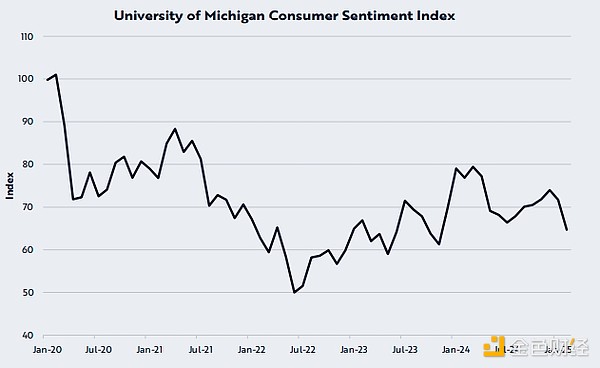
ARK's View: Bearish
According to the University of Michigan Consumer Sentiment Survey, consumer confidence is below pre-election levels.
• Households appear to be cautious and delaying purchases until the impact of new policies becomes clearer.
• Evidence of this caution is the decline in actual consumer spending in January and the lowered expectations of companies like Walmart and Target.
Walmart's Lowered Guidance Suggests More Cautious Consumers
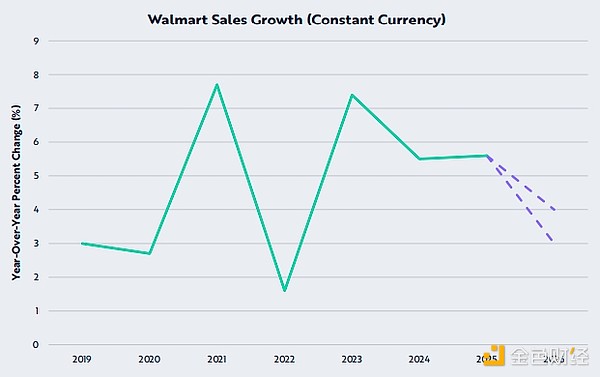
ARK's View: Bearish
Walmart may have benefited from pre-tariff buying in Q4 as consumers rushed to avoid tariff hikes.
• The retailer recently lowered its fixed-rate sales growth forecast for fiscal year 2026 from 5% last year to 3-4% (the purple line in the chart), a 30% slowdown in growth.
• The change in guidance underscores the increasingly cautious attitude of consumers and portends a continued slowdown in retail spending.




